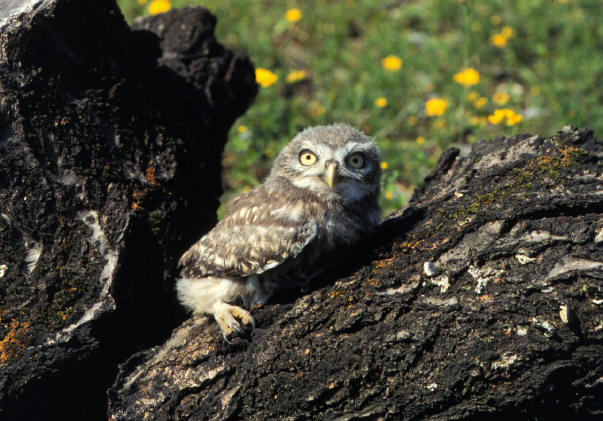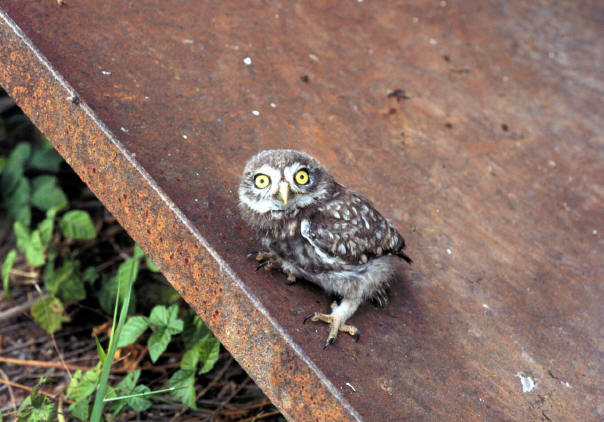Distribution of the Little Owl Athene noctua in Italy
In Italy, the Little Owl Athene noctua is a sedentary species but locally, and especially in winter and autumn, some wandering displacements are possible.
Sometimes autumn drifts can be considered as migratory.
Wide is the distribution on all the Mainland, but it can also be found in the isles like
Sardinia, Sicily and others (Casini L. in Meschini E. & S.Frugis, 1993). On the contrary in Corsica, Little Owl suffers from Scops Owl (Otus Scops)
competition and only two nest-sites (the last one during year 2000) are known in the last century (Thibault & Bonaccorsi, 1999, Mastrorilli, 2000) both
located in the middle-east plain, near Alerià.
It is a well distributed bird of prey in lowland areas and hillsides, with rare occurrences in zones of
low mountains. These facts explain some gaps in the distribution of the Little Owl along the Alpine Arc.
Nevertheless during the last years some
nest-sites have been noticed at higher altitudes: 1000 l.s.m. in Liguria (Andreotti in AAVV, 1989), at 1100 l.s.m. in Piedmont (Mostini in Mingozzi et al.,
1988) and the highest in Western Europe has been noticed on the Orobic Alps in Lombardia at 1230 m l.s.m. (Mastrorilli, 2001).
In Italy censuses of Little Owl distribution are not frequent but on lowland areas smaller densities have been noticed, particularly where intensive
mono-species agriculture is applied.
The Little Owl has a preference for open environment and along tilled fields, settling on rural buildings, hollowed
trees (recently regressing) and garrets in town houses.
Some breeding sites, located in towers and bell-towers, following recent restorations have been abandoned.
In the last years the Little Owl has become the most common bird of prey of Italian towns; such growth is due to the
high number of Urban Parks and wooded boulevards (with preference for species such as Poplar, Plane and Horse-chestnut), to the urbanisation of
country buildings and to the favourable characteristics of historical centres (old buildings with several hollows) and new industrial areas.
Industrial buildings recently built are often used as breeding sites (previously unseen) taking advantage of roof air-spaces (Mastrorilli, 1999)
Due to the different weather conditions, along the Peninsula, there are several areas that can be colonised by the Little Owl. In Po Plain, Little
Owl diffusion can be strongly affected by tough winters (snow and very low temperatures) causing a significant population decrease.
In central-southern Italy, environment and weather conditions are typically
Mediterranean, thus more suitable to this night-time bird of prey ecology and for this reason populations are more stable.
Especially in southern Italy there are the most favourable conditions (suitable weather, major food availability, suitable habitat) for Little Owl
growth, but due to the shortage of ornithological research we can not provide a real analysis.
On numerous in-town censuses, Little Owl presence has been certified in 52 big Italian towns.
In Table I data relates to the presence in some Italian towns.
Bergamo, Lombardia 1997-2000 - 23km2, 34 pairs. Mastrorilli M., 2001
La Spezia,Liguria 1994-95 - 51km2, 11 pairs. Biagioni M.,et.al. 1996
Livorno, Toscana 1992-93 - 38.1km2, 30 pairs. Dinetti M., 1994
Firenze, Toscana 1986-88 - 102.4km2, 52 pairs. Dinetti M, Ascani P., 1990
Pavia, Lombardia 1997-98 - 33km2, 33 pairs. Bernini F. et. al., 1998
Cremona, Lombardia 1990-93 - 10.23km2, 17 pairs. Groppali, 1994
Roma , Lazio 1989-93 - 360km2, 217 pairs. Cignini B., Zapparoli M., 1996
Biella, Piemonte 1998 - 30.75km2, 8 pairs. Bordignon L., 1999
Napoli, Campania 1990-94 - 117.3km2, 48 pairs. Fraissinet M., Milone M,1995
San Donà d. Piave, Veneto 2000 - 21.05km2, 23 pairs. Sgorlon G.,in print
Marcon,Veneto 1988 - 25.39km2, 15 pairs. Stival E., 1990
Cossato, Piemonte 1995 - 34.75km2, 10 pairs. Bordignon L.,1997
Crema, Lombardia 2000-01 - 22.75km2, 18 pairs. Mastrorilli M., in print
Studies about Little Owl distribution in natural areas (out of the city) are rare; among them we can mention the studies in Table II.
Plain of Modena, Emilia Romagna 1987-1990 - 9.3-11 pairs/km2. Estoppey F., 1992. Nos Oiseaux
Plain of Bergamo, Lombardia 1995-96 - 0.69 pairs/km2. Mastrorilli M., 1997. Riv. Mus. Civ. Sc.Nat. BG
Regional Parks of Ticino, Lombardia 1975-78 - 1.1 pairs/km2. Cesaris C., 1988. Avocetta
Castel Porziano, Lazio 1997-98 - 3.14 - 4.62 pairs/km2 .Tomassi et. al.,1999. Avocetta
Tolfa Mountains, Lazio 1994 - 0.55 pairs/km2 .Centili D., 1995, Avocetta
Plain of Pavia, Lombardia 1995-97 - 0.4 pairs/km2. Pirovano A., Galeotti P., 1999. Avocetta
Bibliography
Andreotti in A.A.V.V.,1989 - Atlante degli uccelli nidificanti in Liguria Regione Liguria,
Associazione Studi Ornitologici Italia Meridionale (A.S.O.I.M.) 1995.
Atlante degli uccelli nidificanti e svernanti nella Città di Napoli. Electa, Napoli: 264 pp.
Bernini F., Dinetti M., Gariboldi A., Matessi G., Rognoni G., 1998. Atlante
degli uccelli nidificanti a Pavia. Comune di Pavia. LIPU. pp.192
Biagioni M., Coppo S., Dinetti M. & Rossi E. 1996. La conservazione della
biodiversità nel Comune della Spezia. Comune della Spezia: 302 pp
Bordignon L. 1997. Atlante degli uccelli nidificanti a Cossato. Anno
1989-Anno 1995. Quaderni di Educazione Ambientale. Comune di Cossato (VC): 102 pp.
Bordignon L. 1999. Gli uccelli dellla Città di Biella. Comune di Biella: 86 pp
Casini L. in Meschini E.,S.Frugis, 1993 - Atlante degli uccelli nidificanti in Italia Suppl. Ric. Biol.Selvaggina vol XX 1:344
Centili D. 1995.Dati preliminari sulla Civetta Athene noctua in un'area dei Monti della Tolfa (Roma). Avocetta 19:113.
Cesaris C. 1988. Popolazioni di Allocco Strix aluco e di Civetta Athene
noctua in un'area del Parco Lombardo della Valle del Ticino. Avocetta 12:115-118.
Cignini B. & Zapparoli M. 1996. Atlante degli Uccelli Nidificanti a Roma Fratelli Palombi Editori. Roma: 37.
Dinetti M. & Ascani P. 1990. Atlante degli uccelli nidificanti nel Comune di Firenze. Studio GE9, Firenze: 128 pp
Dinetti M. 1994. Atlante degli uccelli nidificanti a Livorno. Quaderni dell'ambiente, n. 5, Comune di Livorno e Coop. ARDEA: 174 pp
Estoppey F. 1992.Une densité elevée de Chouettes cheveches, Athene noctua, dans la plaine du Po en Italie. Nos Oiseaux 41:315-319.
Groppali R. 1994. Gli uccelli nidificanti e svernanti nella Città di Cremona (1990-1993). Azienda Energetica Municipalizzata e Museo Civico di Storia
Naturale, Cremona: 176 pp
Marcolin C. & Zanetti M. 1999. Uccelli in città. Atlante degli uccelli
nidificanti nell'area urbana di San Donà e Musile di Piave. Edizioni Associazione Naturalistica Sandonatese:136 pp.
Mastrorilli M. 1997. Popolazioni di Civetta (Athene noctua) e selezioni
dell'habitat in un'area di pianura della provincia di Bergamo. Riv. Mus. Civ.
St. Nat. "E. Caffi" Bergamo 19:15-19.
Mastrorilli M. 1999.Caratteristiche dei ricoveri e dei siti riproduttivi di
Civetta Athene noctua nelle province di Bergamo e Cremona. Avocetta 23:163.
Mastrorilli M., 2000. Seconda nidificazione di Civetta Athene noctua, in Corsica. Riv. Ital. Orn. 70:89-91
Mastrorilli M., 2001. Little Owl Athene noctua status and habitat selection
in the town of Bergamo (Lombardy, Northern Italy). In : The Little Owl in
Flanders in its international context. Proceedings of the Second
International Little Owl Symposium, 16-18 March 2001. Geraardsbergen,
Belgium. Van Nieuwenhuyse D., Leysen M. and Leysen K. (Eds.) Oriolus
67(2-3):136-141
Mastrorilli M., in print, La comunità ornitica nidificante della città di Crema (CR) nel biennio 2000-2001. Riv. Ital. Orn.
Mostini L. in Mingozzi T.,G.Boano,C.Pulcher,1988 - Atlante degli uccelli nidificanti in Piemonte e Valle d'Aosta Monograf. VIII.Mus. region. Sc.Nat., Torino
Pirovano A. & Galeotti P. 1999.Territorialismo intra- e interspecifico della
Civetta Athene noctua in provincia di Pavia. Avocetta 23:139.
Sgorlon G., in print, Densità e spaziatura dei siti di nidificazione di
Civetta Athene noctua in un ambiente urbano del Veneto Orientale. Avocetta
Stival E. 1990. Avifauna e ambienti naturali del Comune di Marcon (VE). Club Marcon, Marcon (VE): 184 pp
Thibault J., Bonaccorsi G., 1999 - The birds of Corsica - BOU Chechlist, Series:17
Tomassi R., Piattella E., Manganaro A., Pucci L., Ranazzi L. & Fanfani A.
1999. Primi dati su dieta e densità della Civetta Athene noctua nella Tenuta
Presidenziale di Castelporziano (Roma). Avocetta 23:159.


